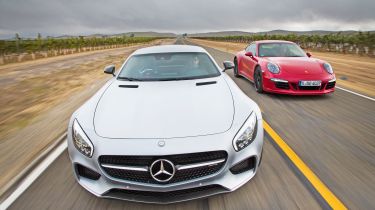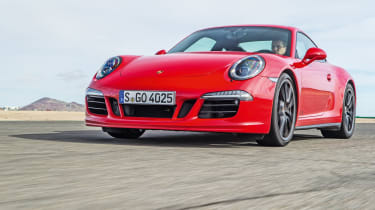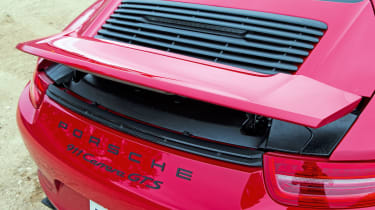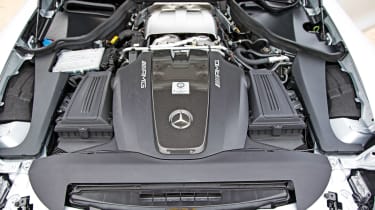Mercedes-AMG GT vs Porsche 911 GTS
Day of reckoning as eagerly awaited new super car meets latest benchmark
Mercedes-AMG GT vs Porsche 911 GTS: on the road
Extensive use of aluminium in the body and suspension has kept weight to a minimum, and as a result the GT S feels sharper and more dynamic than any previous AMG we’ve driven. With a low centre of gravity, long wheelbase and wide tyres, the new Mercedes is planted to the road and very stable. Traction and mechanical grip are sensational, with none of the wriggling and writhing you would expect from a powerful rear-wheel-drive/front-engined car trying to put its power down and control body roll.
On dry tarmac there’s very little intervention from the stability control and the GT S’ standard electronically controlled locking rear differential does a very good job of maintaining traction. For a front-engined car, there’s also very little understeer, and you get no sense of there being too much weight in the nose. In fact, that low and tucked back engine helps the GT S to a 47:53 per cent front to rear weight distribution.
The variable ratio steering is light and fast, and adds to the Mercedes’ positive front end. However, it lacks the feel and fluidity of the 911’s steering. And as good as the AMG GT S is, there’s still no ignoring the 911’s delightfully precise and eager steering. Thread the GTS down a tight and twisty road, and the fluidity with which it flows from corner to corner is joyful – the GTS gets close to matching the stunning 911 GT3 in terms of pure engagement.
Used - available now

2023 Audi
Q4 Sportback e-tron
54,526 milesAutomaticElectric
Cash £23,363
2022 Kia
Niro
18,315 milesAutomaticPetrol1.6L
Cash £17,900
2023 Nissan
Juke
40,858 milesManualPetrol1.0L
Cash £12,287
2022 Volkswagen
T-Roc
36,779 milesAutomaticPetrol1.5L
Cash £18,600• What's the fastest car in the world?
Beautifully balanced and streaming with feel and feedback, the Porsche immediately inspires confidence and interaction. In the AMG GT S, you need to trust that the front-end bite is there, rather than feel it – although once into the corner the Mercedes’ composure is hard to fault.
Better still, for all its tautness and grip, the AMG is a great day-to-day sports car. The suspension is just the right side of firm, and on smooth tarmac with the dampers in Comfort Mode, the GT S rides well enough to be comfortable. The wide tyres generate some road noise, but not as much as the Porsche’s – with its 10mm lower PASM suspension set-up, the GTS has a slightly harder edge to its ride.
Both cars allow plenty of dynamic adjustment of the throttle, suspension, stability control and steering. The AMG Dynamic Select system offers Comfort, Sport and Sport Plus settings, plus a programmable Individual mode that lets you set up your personal preference of steering, exhaust, throttle and gearbox modes. Go for the £1,795 Dynamic Plus Pack, and you get a Race mode, plus active engine and gearbox mounts that stiffen under load to boost handling or soften when cruising to help refinement.
The 911 GTS includes these as part of the standard Sport Chrono Pack, and you can choose Sport and Sport Plus modes for drivetrain and chassis. Sports exhausts feature on both cars, too, and it’s hard to choose between the harsh mechanical bark of the Porsche’s free-revving flat-six or the Mercedes’ hard-edged V8. Both deliver amazing aural delights, but with a more natural blend of engine note and tailpipe crackle, the silky smooth 911 GTS just edges it.
The AMG’s soundtrack is much more about the exhaust note than the engine itself, which is slightly muffled by its twin-turbos. Having said that, anyone who thought an AMG V8 with turbos would be devoid of character can rest easy, as it still sounds superb.
And as you’d expect for a company famed for its “one man, one engine” hand-built power units, the new 4.0-litre V8 is at the heart of the GT’s appeal. Press the start button and it settles into a smooth burble at low speeds, and aside from a slight hesitation from the dual-clutch transmission as you pull away, there’s huge power on tap throughout the rev range.
With 650Nm of torque – 200Nm more than in the 911 – from as low as 1,750rpm, the 503bhp GT S feels instantly responsive, yet peak power doesn’t arrive until 6,250rpm, so there’s performance on offer throughout the rev range. The Merc is amazingly quick, rocketing off the line and covering 0-62mph in 3.8 seconds – a figure matched by the 911 GTS.
On the road, both cars have more performance than you’ll ever need, but with less torque and a 79bhp deficit, the Porsche’s engine has to be worked a bit harder. Not that it’s a chore, as the creamy flat-six just pulls and pulls through the revs, and sounds better as you climb towards the red line.
Unlike the Mercedes, there’s the option to go for a manual gearbox, but most people are likely to opt for the dual-clutch PDK – as with the similar DCT box in the Mercedes, it’s hard to fault. Both transmissions offer fast and smooth upshifts at the touch of a paddle, and slot each downchange into place with a nice throttle blip.
Ceramic brakes are options on both cars, but the Porsche has a smoother pedal feel, although neither model is exactly short on stopping power.
Click to page 3 for full specs, running costs and practicality.











